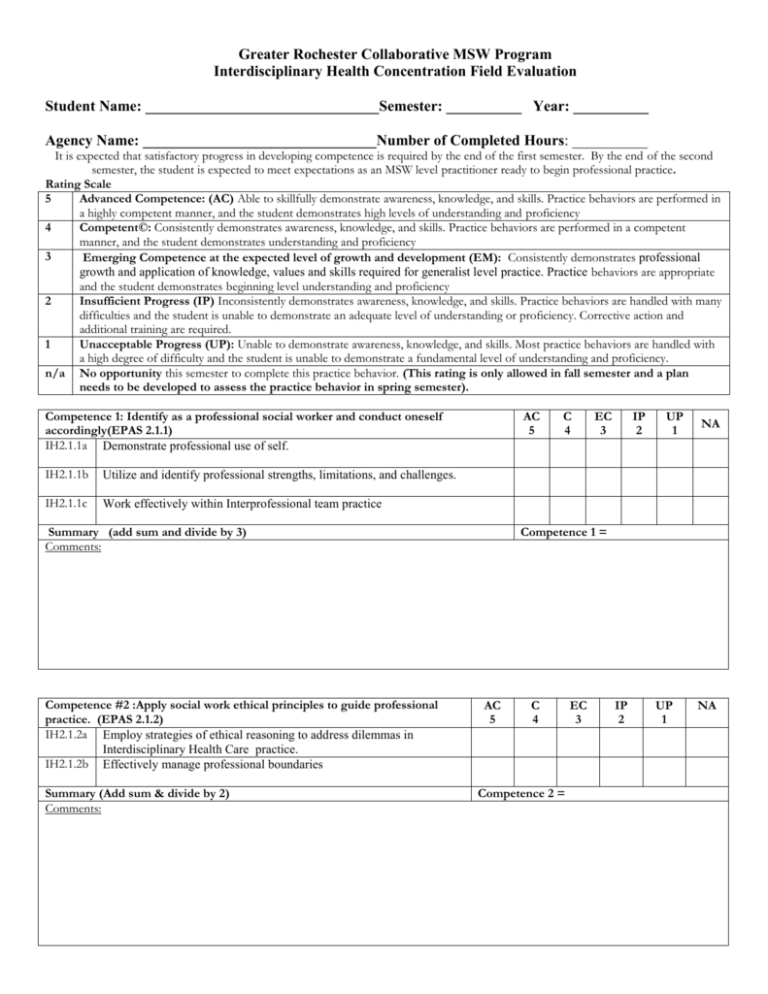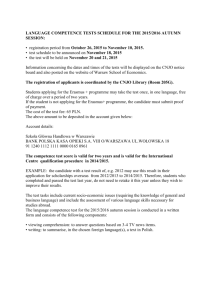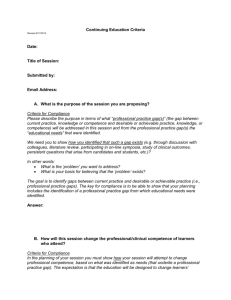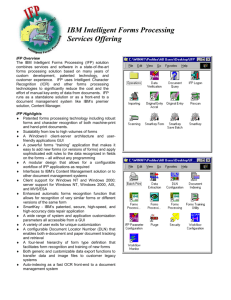Field Evaluation
advertisement

Greater Rochester Collaborative MSW Program Interdisciplinary Health Concentration Field Evaluation Student Name: _______________________________Semester: __________ Year: __________ Agency Name: _______________________________Number of Completed Hours: __________ It is expected that satisfactory progress in developing competence is required by the end of the first semester. By the end of the second semester, the student is expected to meet expectations as an MSW level practitioner ready to begin professional practice. Rating Scale 5 Advanced Competence: (AC) Able to skillfully demonstrate awareness, knowledge, and skills. Practice behaviors are performed in a highly competent manner, and the student demonstrates high levels of understanding and proficiency 4 Competent©: Consistently demonstrates awareness, knowledge, and skills. Practice behaviors are performed in a competent manner, and the student demonstrates understanding and proficiency 3 Emerging Competence at the expected level of growth and development (EM): Consistently demonstrates professional growth and application of knowledge, values and skills required for generalist level practice. Practice behaviors are appropriate and the student demonstrates beginning level understanding and proficiency 2 Insufficient Progress (IP) Inconsistently demonstrates awareness, knowledge, and skills. Practice behaviors are handled with many difficulties and the student is unable to demonstrate an adequate level of understanding or proficiency. Corrective action and additional training are required. 1 Unacceptable Progress (UP): Unable to demonstrate awareness, knowledge, and skills. Most practice behaviors are handled with a high degree of difficulty and the student is unable to demonstrate a fundamental level of understanding and proficiency. n/a No opportunity this semester to complete this practice behavior. (This rating is only allowed in fall semester and a plan needs to be developed to assess the practice behavior in spring semester). Competence 1: Identify as a professional social worker and conduct oneself accordingly(EPAS 2.1.1) IH2.1.1a Demonstrate professional use of self. IH2.1.1b Utilize and identify professional strengths, limitations, and challenges. IH2.1.1c Work effectively within Interprofessional team practice AC 5 Summary (add sum and divide by 3) Comments: Competence #2 :Apply social work ethical principles to guide professional practice. (EPAS 2.1.2) IH2.1.2a Employ strategies of ethical reasoning to address dilemmas in Interdisciplinary Health Care practice. IH2.1.2b Effectively manage professional boundaries Summary (Add sum & divide by 2) Comments: C 4 EC 3 IP 2 UP 1 NA Competence 1 = AC 5 C 4 Competence 2 = EC 3 IP 2 UP 1 NA Competence # 3: Apply critical thinking to inform and communicate professional judgments. (EPAS 2.1.3) IH2.1.3a Utilize theoretical perspectives, research, and practice knowledge and apply them to client situations AC 5 C 4 EC 3 IP 2 UP 1 NA UP 1 NA IH2.1.3b Integrate and communicate professional judgments to other social workers and to professionals from other disciplines in both verbal and written formats. Summary (Add sum & divide by 2) Comments: Competence 3 = Competence #4: Engage diversity and difference in practice. (EPAS 2.1.4) IH2.1.4a AC 5 C 4 EC 3 IP 3 Address the cultural, spiritual and ethnic values and beliefs of client systems in understanding their perspective on health practices IH2.1.4b Translate cultural competence into practice skills of assessment, treatment planning & intervention to enhance client physical and mental health & well-being. Summary (Add sum & divide by 2) Comments: Competence #5: Advance human rights and social and economic justice. (EPAS 2.1.5) IH2.1.5a Identify and use knowledge of relationship dynamics, including power differentials to advocate at multiple levels for economic, employment, health, education and housing equality. IH2.1.5b Understand the potentially challenging effects of economic, social, environmental and cultural factors in the lives of clients and client systems in health and mental health treatment. Summary (Add sum & divide by 2) Comments: . Competence 4 = AC 5 C 4 EC 3 Competence 5 = IP 2 UP 1 NA Competence #6: Engage in research-informed practice and practice-informed research. (EPAS 2.1.6) IH2.1.6a Reviewing evidence based literature related to health and mental health care topics. IH2.1.6b Demonstrate the knowledge of program evaluation and in achieving intended health outcomes. IH2.1.6c Use of research including evidence-based practice to evaluate and enhance the effectiveness of social work and health care practice. Summary (Add sum & divide by 3) Comments: Competence #7: Apply knowledge of human behavior and the social environment. (EPAS 2.1.7) IH2.1.7a Demonstrate knowledge of theoretical perspectives that inform health care practice inventions. IH2.1.7b Apply theories of human behavior and the social environment to guide social work and health care practice. Summary (Add sum and divide by 2) Comments: AC 5 C 4 EC 3 IP 2 UP 1 NA EC 3 IP 2 UP 1 NA EC 3 IP 2 UP 1 NA Competence 6= AC 5 C 4 Competence 7 = . Competence #8: Engage in policy practice to advance social and economic well-being and to deliver effective social work services. (EPAS 2.1.8) IH2.1.8a Identify the connection between clients, practice, and both public and organizational policy. IH2.1.8b AC 5 C 4 Advocate to influence health and mental health policies that affect clients and health care services. Summary (Add sum and divide by 2) Comments: Competence #9: Respond to contexts that shape practice. (EPAS 2.1.9) IH2.1.9a Demonstrate knowledge of current social contexts and trends that affects client health and mental health systems. IH2.1.9b Work collaboratively with key stakeholders to effect systemic change that is sustainable. Competence 8 = AC 5 C 4 EC 3 IP 2 UP 1 NA Summary (Add sum & divide by 2) Comments: Competence 9 = Competence #10: Engage, assess, intervene and evaluate with individuals, families, groups, organizations, and communities. (EPAS 2.1.10) Engagement (EPAS 2.1.10a) AC C EC IP UP 5 4 IH2.1.10a Develop culturally responsive therapeutic and collaborative relationships. IH2.1.10b Manage the dynamics and contextual factors that both strengthen and potentially threaten the therapeutic and working relationship. IH2.1.10.c Maintain a rapport that encourages client (s) to be equal participants in the working relationship. Assessment (EPAS 2.1.10 b) IH2.1.10d Conduct comprehensive assessments. IH2.1.10e IH2.1.10f Select and modify appropriate intervention strategies based on continuous assessment. Administer and interpret standardized assessment and diagnostic tools. IH2.1.10g Contribute to interdisciplinary team assessments of client and community systems Intervention (EPAS 2.1.10c) IH2.1.10h Apply best practices and evidence-based interventions to health and mental health related service delivery. IH2.1.10i Collaborate with other professionals to coordinate interventions. IH2.1.10j Effectively mobilize resources and assets to enhance client system capacity Evaluation (EPAS 2.1.10d) IH2.1.10.k Develop clear, timely, and appropriate intervention plans with measureable objectives and outcomes. IH2.1.10l Demonstrate the knowledge of practice evaluation in achieving intended health outcomes. IH2.1.10m Based upon the results of evaluation, adjust interventions plans on a continuing basis and appropriately disseminate findings. Summary (Add sum & divide by 12) Comments: Competence 10 = 3 2 1 NA Summary of Quality Points by Competency (worksheet) Summary of Scores (worksheet) Competence 1 Competence 2 Competence 3 Competence 4 Competence 5 Competence 6 Competence 7 Competence 8 Competence 9 Competence 10 Unsatisfactory 2.9 and lower Sum of scores divided by 10 Please describe the student’s strengths and areas of accomplishment: (Please attach additional sheets as needed) Please indicate areas requiring further development and improvement: (Please attach additional sheets as needed) Satisfactory 3.0 and higher Student Section: I am in agreement with this evaluation: Yes No Student Comments: Signatures Field Instructor Name: Signature: Date: Student Name: Signature: Date: Faculty Liaison Name: Signature: Date: Field Education Office Review: Signature: Date:








